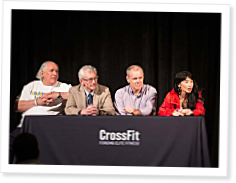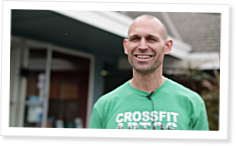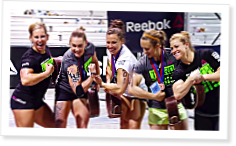by Kyle Mask
“It has been my observation that experienced lifters – those who have been at it for half a decade or more and think they have the answers – almost invariably do not even remember what they did as novices. But almost assuredly, what they did IS NOT what they now recommend.”
Read More
var addthis_config = {"data_track_addressbar":true};
After training for nearly a decade at a commercial gym in one of Nashville’s poshest neighborhoods, I firmly believed I had seen every possible iteration of tomfoolery and Silly Bullshit applied to the training of novices. Scenes of corpulent, nearsighted, middle-aged men in company polos nodding approvingly as anorexic housewives craned their necks heavenward while repeatedly unlocking and locking their knees under the crushing force of empty Smith machines long ago ceased to bemuse me. Single-leg Bosu ball alternating arm curls, thirty minute conversations on leg extension machines inconveniently interrupted by the occasional “work” set, five pound dumbbell benches with arms-extended crunches tacked on to the end of the movement – none of this fazed me. I had mastered the art of looking the other way, of living and letting live, of ensuring that I trained as well as I knew how, while allowing the rest of the world to hurdle headlong into the abyss. Others were not always as tolerant of me as I was of them. The odd trainer infrequently mustered the courage to apprise me of the eventual injuries to my knees, back, and shoulders I would inevitably incur. Sixty-five year old retired physicians sometimes would shuffle over and initially feign to fawn over a weight I had just lifted, only to end by lecturing me on the hazards of health imbalances (i.e. being too strong) and the long-term yields of cardio. More than once I was tempted to reply by simply pointing to my nearly sixty-year-old father, who was just finishing a set of five deadlifts with 405 and therefore had no need to shuffle around like a decrepit old man. Alternately, I considered asking them to perform a few heavy sets of five on the squat and report back to me whether their cardio-respiratory capacity had been worked. But as I’m blessed with a naturally ornery disposition, generally I felt no compunction at uttering a simple “Fuck off.” Obviously, such a training environment was far from ideal, but I could handle it and was willing to tough it out, given the gym’s reasonable rates and surprising willingness to supply chalk. I trudged on valiantly in this barbell purgatory until a year ago when, suddenly, a potential reprieve presented itself. Some friends of mine decided to outfit a warehouse for powerlifting. No Bosu balls, no Smith machines, no bullshit. Instead, we would have squat racks, benches, platforms, quality barbells, and enough iron and rubber to moonlight as a dominatrix whorehouse. Besides providing a significant improvement in training atmosphere for us seasoned vets, our club would have the opportunity to attract new trainees, some of whom in short order might even aspire to become serious lifters. I was excited to see what could be accomplished by properly motivated novices under the tutelage of already strong men. As I would soon discover, however, life often presents us with gaping chasms between expectations and reality. Of the dozen or so young men who have begun training in the last year, I have heard of only one who can squat 315x5, and I have not seen it myself. A 315 pound squat does not represent extraordinary novice achievement. Many dedicated trainees attain it within three to six months of following a linear progression. What is extraordinary, however, is the inanity of the instruction all of these beginners received from men much stronger than they are – advice which they consequently found tough to dismiss. It can be exceedingly difficult for a novice to rationally evaluate advice from a man who already embodies his ultimate goals of strength and muscularity. Granted, most of the novices I have observed in the past year lacked adequate knowledge of the process by which strength is attained to permit an assessment of the poor advice they were given. But a few had the requisite foundation. A few were even familiar with Starting Strength (although I cannot vouch that they had actually read the book), and thus should have known better. In the end, however, unspoken appeals to authority won out. The biggest guys in the gym sauntered over to the newbies and promised to make them strong. All the newbies had to do was graciously submit. And unfortunately, without exception, they did.What follows is a catalog of the programming errors I have observed a handful of well-meaning but misguided powerlifters perpetrate on novices in the past year. And if what I see on the internet is any reliable indication, such erroneous advice from experienced lifters is ubiquitous. My intention in chronicling these faults is twofold. First, I want to provide empirical evidence that novices who opt for more complex programming over DTFP are wasting valuable time and effort. Second, I want to propose arguments for why this is the case, which will involve showing why certain kinds of programs are inappropriate for novices, and why linear progression is optimal. My hope is that these arguments will enhance novices’ understanding of why they need to DTFP, and that those novices who find themselves being offered advice by bigger, stronger, more experienced lifters will be better equipped to appraise this advice. If an experienced lifter or two happens to read this and recalls times when he has offered inept advice to novices, perhaps he will realize the error of his ways. Strength, after all, is no guarantor of programming knowledge. One crucial thing to keep in mind about competitive lifters is that many of them fail to understand why they are successful. They realize that they must lift heavier weights in order to get stronger, but this is a mere tautology. It effectively says nothing more than that a lifter must get stronger in order to get stronger. All too often even serious, accomplished lifters fail to appreciate the process of stress/recovery/adaptation upon which all viable programming depends. How, the incredulous novice might be tempted to ask, were these lifters able to become so strong with such impoverished knowledge of the process by which strength is attained? It has been my observation that experienced lifters – those who have been at it for half a decade or more and think they have the answers – almost invariably do not even remember what they did as novices. But almost assuredly, what they did IS NOT what they now recommend. Many of them probably added weight to the bar every workout until they became unable to sustain such steady progress, a concept that should sound eerily familiar. They might not have used three sets of five, and they might not have squatted three times a week, but they did add weight to the bar at regular enough intervals and in sufficient doses of volume to drive substantial progress. This is what I did, even though I had not read Starting Strength and did not know why what I was doing – or at least some of what I was doing – was right. Second, exceptionally strong folks are genetic exceptions, who can be quite strong in spite of significant knowledge deficits. Chances are that you will need a more structured, more rational approach than they required to elicit adaptation.{pagebreak}With this backdrop in mind, consider the following scenario, which I have witnessed myriad times in the past year. A new lifter comes in for his second or third workout and asks the biggest lifter he can find for advice on how to get started. Perhaps the novice has read about linear progression on the internet or someone has told him about it, so he has some basic knowledge of how it is supposed to work. Now, when the big guy hears about the novice’s plan to add five to ten pounds to his squat sets three times per week, he is flabbergasted. He tells the novice that this kind of progress is not sustainable over the long haul and, even more damning, that no world-class lifter uses such a simple program. Of course, everything the big guy said is true. Linear progression is not sustainable long term, and elite lifters do not use programming like that outlined in Starting Strength, at least not once they are past the novice stage of training advancement. Notwithstanding the veracity of his claims, however, they do not constitute objections to the novice’s use of linear progression. Rather, properly understood, they constitute good reasons for the novice’s use of linear progression. Linear progression is optimal for the novice precisely because it is not sustainable long term – that is, because it facilitates the most rapid progress he can sustain initially. And linear progression is not useful for the elite lifter because he cannot apply adequate stress in a single workout from which he can recover and adapt. Nothing more can be inferred from the elite lifter’s inability to successfully employ linear progression than the simple fact that linear progression is not suited to the elite lifter.But the novice is easily swayed. The biggest guy in the gym just told him that nobody with a fucking clue does linear progression. In my experience, the big guy usually proceeds to explain to the novice that he should develop an approach to programming that he can employ over the entire course of his training career. To this end, the big guy recommends a program the novice can use for years to come, usually a percentage based program that sees the novice adding weight to his lifts (or to some sort of projected max) every month, possibly even every three to four months. After all, he will argue, training is a marathon, not a sprint, and this slow, steady approach will promote progress for five, ten, even twenty years down the road. This specious reasoning, however, fails to account for the difference in the length of time that the stress/recovery/adaptation cycle takes to complete at different levels of training advancement. The entire cycle runs its course in 48 to 72 hours for the novice, whereas the cycle might take months, or even years, to elicit an appreciable strength increase for a world-class lifter. Consequently, different stages of training advancement require different kinds of programming, and this is what the big guy has failed to understand.But let us assume that the novice has bought into the poor advice he has just received. In order to work a percentage based program, the very first thing the novice will need to do is establish maxes on which to base his lifts for the entirety of the training cycle, however long that might be. That’s right. A novice, who has never practiced the lifts and who by definition lacks the neuromuscular efficiency to exert anything approaching maximal force on a barbell, will be asked to determine his limit strength. Even if he uses, say, a 5-rep max to estimate his 1RM, the 5-rep max is just as useless, for the novice lacks the ability to exert maximal force on the barbell for any number of repetitions. Asking the novice to establish a max is tantamount to throwing a fifteen-year-old virgin boy in front of a camera for a threesome with Gianna Michaels and Rachel Starr and expecting thirty minutes of cinematic gold. I don’t care if the kid is blessed with a 10-incher, chances are he won’t be able to use it effectively. Likewise, I don’t care if a novice has a 36-inch standing vertical jump; if he hasn’t squatted before, he won’t be efficient enough at squatting to exert maximal force on the barbell. If you are a novice and a more experienced lifter advises you to max on your first day, or to “perform a strength evaluation,” as I have heard one lifter tell a half dozen novices in the past year, RUN – do not walk – the other direction.Even more absurd, the numbers established on the first day will determine the amount of weight the novice has added to the bar by the end of the training cycle. Because the weights used for each workout of a percentage-based program are derived from the max (or estimated max) established at the beginning of the training cycle, progress for the entire cycle is constrained by the lifter’s performance on the very first day of training. To illustrate the inherent absurdity of this programming for the novice, consider two lifters: The first is a 300-pound twenty-year-old, who is exceptionally uncoordinated due to a sedentary childhood spent indoors playing video games, but who has a genetic capacity for a 900 pound squat. Due to his poor initial coordination, conditioning, and strength, he squats 135x5 on his first day, from which he derives a training max of 160 pounds. The second individual is a slight-framed 165-pound twenty-year-old, who plays second base for a Division II college program. He is preternaturally coordinated and has spent most of his life sprinting and performing other athletic activities that have resulted in his ability to play college baseball despite his diminutive frame. He begins lifting and, like the first individual, squats 135x5 his first day for a training max of 160 pounds. However, he exhibits little of the heavier novice’s first day awkwardness in performing the movement, instead looking from the outset like he has been squatting for a few weeks already. Despite his genetic ceiling for the squat being 450 pounds – only half that of the deconditioned couch potato – percentage based programming dictates that both will lift the exact same weights for the duration of the training cycle.It should be obvious that the first individual has the ability to increase the weight on the bar at a much faster rate than the second individual. The first lifter will perform the lift much more fluidly with each successive workout, and he will cease to be excessively winded at the culmination of his work sets after only a few workouts. The second lifter, on the other hand, will become somewhat more efficient at performing the movement, but he lacks the potential for quick improvement in athletic parameters other than strength, as well as the high genetic ceiling of the first lifter. Were the first lifter to follow a linear progression, given his high genetic ceiling, he might add 15 to 20 pounds to his squat sets three times per week for a month before “only” adding 10 pounds per workout for a couple of months. Yet the second lifter might find it difficult to add 10 pounds per workout for even three weeks before switching to 5-pound increases. Why, then, would any intelligent individual recommend that these two lifters use the same weights for weeks, even months, on end?More general arguments further prove the inadequacy of percentage-based programming for the novice. For instance, consider the aforementioned attempt by the novice to establish some sort of strength baseline on the very first day of training. By definition, the novice is one for whom almost any strenuous activity serves as a stimulus sufficient to produce an adaptation. Thus, the novice who performs a 5-repetition “max” on the first day, or even a bumbling, unbalanced 1-repetition “max”, has done enough work to elicit an increase in strength. This increase in strength, in turn, means that the number on which the novice bases the remainder of his training cycle is invalid. The very act of performing the test on the first day negates the result. One might object that the strength obtained from this one workout is negligible and therefore only marginally impacts the results arrived at by the end of the training cycle. This objection evinces an abject failure to appreciate the strength a novice can acquire from a single workout. A 5 to 10-percent increase in strength from a single workout is normal for a novice, and such a drastic increase certainly renders obsolete the test results from the first workout. The 300-pound novice above who performs even a single set of 135x5 on the first day might find himself capable of 155x5 only a day or two later. So why in the hell will he be working with an assumed one-rep training max of 160 for his next workout? And when one imagines him working with that 160-pound training max for weeks or months on end – as many powerlifters would have him do – when in fact he would be capable of squatting 375 for 5x3 after a month of linear progression during which he added 20 pounds per workout, the stupidity and wasted potential is staggering. {pagebreak}Percentage-based programs which might be entirely appropriate for the intermediate or advanced lifter impede the novice’s progress. The intelligent programmer wants that 300-pound twenty-year-old who is genetically capable of squatting 900 pounds to be squatting close to that number when he is twenty-three so that he can enjoy a long and productive competitive career. Artificial limits imposed on him by arbitrary percentages might even drag the process out for so long that he grows old without realizing his potential. Similar reasoning applies for the less genetically gifted lifter, who deserves the right to fulfill his potential as expediently as possible. Strong is better than weak, and he should be able to spend more of his life being strong rather than weak.Well, after months of decrying the ills of percentage-based programs for novices to all who would listen in our gym, some apparently began to rethink their approaches. I started to hear about novices performing sets of five with weight increased incrementally every single workout. Sadly, however, this also proved to be but an illusory breakthrough. When I inquired into the specifics of these programs, two flaws became apparent.A program that one powerlifter designed for a former Division I college football player (who is nevertheless a novice) reveals both flaws, and therefore serves as a useful example. The gist of this program is that the novice performs 5 sets of 5 across on squats, benches, deadlifts, and push presses. As the lifter was explaining this to me, I thought it sounded pretty good. Sure, 5 sets is too many, but thus far it represented a substantial improvement over the nonsense I had heard in the past. He then informed me that each lift was to be performed on a separate day, one day per week, with 5 pounds added to the work sets each week. Despite the advance of this approach over percentage based programming, it nevertheless fails to take advantage of the novice’s ability to rapidly adapt to stress. As the entire stress/recovery/adaptation cycle runs its course in 48 to 72 hours for the novice, he is capable of adding weight to each lift multiple times per week, provided the lifts are properly spaced and are followed by appropriate intervals of rest. Whereas the football player on the slow linear progression above will add 20 pounds to his squat in one month, a more aggressive approach – and one that is not recklessly aggressive, but aggressive within reason – would see him take 10 pound jumps three times weekly for an increase of 30 pounds to his squat in one week and 120 pounds in one month. Thus, he will spend six months on his current program attaining the strength that he could have acquired in one month of an approach that intelligently exploited his full potential to adapt to stress.When I raise such objections in the gym – objections that seem to me self-evident – I generally am met with a common refrain: there will be no difference two years in the future between the slow linear approach and the quick approach. The novice will end up just as strong either way. So what’s the rush? Let him build confidence by sustaining easy progress for as long as possible. This line of response concedes the quick approach’s capacity to produce a superior physiological response to a training stimulus, but it bemoans the negative psychological consequences of trying to get strong too fast. If the easy gains dry up in three months, it is argued, the lifter will become bored, frustrated, and perhaps even quit.Not only do my anecdotal observations contravene this argument, but it is readily apparent why the argument does not ring true psychologically. Consider a novice, previously sedentary but with reasonably good genetic potential, who squats 135 for sets of 5 his first workout. After one month of the slow linear approach where he performs each lift only once per week, adding 5 pounds per workout, he squats 155 for sets of 5. He still feels weak, everyone around him still sees him as weak, and, in fact, he still is weak. When he has to take a heavy trash bin out to the road, or open a pickle jar for his wife, or help a friend move a couch, he sees that his training has had little effect. It might be perfectly reasonable for him to ask: What’s the point? Had he added 10 pounds per workout for 3 weeks and 5 pounds per workout for the fourth week, however, he would have been squatting 245 for 5x3 at the month’s end. Now the trash bin and couch would feel light, the top would pop right off the pickle jar, and the man would be stronger than the vast majority of the population. Now he would see that his training has a purpose, and purpose begets confidence. The detraining that occurs between workouts in the slow approach has additional deleterious psychological consequences. When the above novice squats 135 for 5s for his first workout on a Monday, his body is ready to attack 145 for 5s on Wednesday, and after this, 155 for 5s on Friday. If, however, after the initial Monday workout he does not train on Wednesday, when his body is ready, the adaptation that occurred as a result of Monday’s workout and the subsequent recovery period begins to be lost. After about 48-72 hours, his strength declines until the next time he squats. If this happens to be one week later on the following Monday, 140 might feel as heavy as 145 would have felt only 48 hours after his first workout. And two weeks after the first workout, 145 might feel as heavy as 155 would have felt only 96 hours after the initial workout. This conditions the novice to think that weights are heavy that are not actually heavy – that would not even feel heavy had he trained appropriately. Perception all too quickly becomes reality, and two months into the program the novice is dreading having 175 on his back, when he should have been able to plow through this weight the second week of training. Make no mistake, the novice’s perception of what constitutes “heavy” will impact not only short term progress, but long term gains as well, and very well might keep him from realizing his potential.The final novice programming error I have observed in the past year probably stems from the tacit realization that performing each lift only once per week represents a suboptimal training stimulus, even resulting in detraining between workouts as discussed above. Rather than admit that the solution to the problem is increasing frequency, the obstinate programmer will attempt to make each workout more stressful, so that the novice will require the full week between lifts to recover. Assuming that the programmer has enough sense not to alter the variable of intensity for a novice, the variable he manipulates must be volume. Probably also implicitly aware that making a novice perform more than a handful of sets for a major exercise constitutes heinous abuse, the programmer will add volume by adding assistance/accessory work. Recently I watched a novice perform 5x5 on the bench for his first workout, after which he did several sets each of dumbbell bench presses and incline presses, followed by a bevy of silly single-joint movements. Had the bullheaded powerlifter who oversaw the workout admitted that he was manipulating the wrong training variable (and really, no training variable other than load should be manipulated for the novice), this novice lifter could have increased the poundage on his bench multiple times in the same week. As it stands, however, the trainee ended up needlessly sore, and to add insult to injury, weaker on the bench the following week than he could have been. {pagebreak}I also have heard powerlifters attempt to justify assistance/accessory work for the novice on other, more dubious grounds than simple volume accumulation. Apparently, the low bar squat fails to adequately train the quadriceps, so front squats, leg presses, and/or leg extensions should be added, even for the novice. Or to cite an example I personally witnessed several months ago, a powerlifter observed a novice’s deadlift and concluded that the novice was weak off the ground. To remedy this, the powerlifter prescribed deficit deadlifts after the novice’s regular deadlift sets.Of course, the exercises recommended for the novice in Starting Strength were chosen because they involve the most muscle mass over the longest effective ranges of motion with the heaviest weights, thereby producing the greatest possible gains in total body strength. When something extraneous is added, something vital must suffer. The body’s recovery resources are finite, and a properly designed program already should be stretching these resources to their limit. Hence, when front squats are added “for extra quad development” or some equally asinine reason, the novice must spend valuable recovery resources on this lighter exercise that would have been better spent recovering from an exercise that worked more muscle mass with heavier weight, thus resulting in greater strength gains (i.e. squats). Even seemingly innocuous additions, such as curls, will adversely affect the novice’s ability to recover from squats and deadlifts. The more energy the novice devotes to less-effective exercises, the less energy he can devote to more-effective exercises. There is, however, an even more obvious reason why adding assistance/accessory work to a novice linear progression is first-rate buffoonery. Take the novice deadlifter above who added deficit deadlifts to his program to improve his strength off the ground. He is not weak off the ground and strong at lockout, as the powerlifter who recommended deficit deadlifts told him. Rather, his entire fucking body is weak. This particular individual was struggling to deadlift 225 for a few reps when the powerlifter who suggested deficit deadlifts observed his pull. So what if his lockout is comparatively easier than his initial pull off the ground? His lockout is still appallingly weak. And the answer is to have him do more work with a weight that is lighter both off the floor and at lockout? One must recognize that the novice has no weak points – he simply IS weak. Consequently, he is best served by performing heavy compound lifts through their entire effective ranges of motion. Any attempt to isolate specific weaknesses by the coach or trainee demonstrates a failure to grasp this important concept: the systemic weakness of the novice, as well as the systemic nature of the stress and adaptation produced by the basic barbell lifts when performed through their entire effective ranges of motion. The novice has neither weak nor strong points. Indeed, he is best conceived as an amorphous blob of weakness that most efficiently will assume human form by performing the basic barbell lifts. Only once he has attained this form can he begin to identify specific weaknesses and train accordingly.My venture out of the land of squat rack curlers and into a gym that emphasizes heavy barbell training has revealed to me an entirely new and unexpected set of problems. I have witnessed the consequences when novices abandon simple linear progression in favor of training approaches that are incommensurate with their level of training advancement. Almost as disheartening as these novices’ failure to add any appreciable strength or muscle mass is the fact that those offering advice – those in positions of authority – should have known better. Contrary to common meathead opinion, the strongest guy in the gym might not be the best guy to ask for advice. There is a good chance that he got where he is despite his ignorance of proper programming principles, and not because he is a deep reservoir of training knowledge. I encourage novices to apply rigorous logical analysis to the organization of their training, and not to fall for vacuous appeals to authority. If a novice decides a simple linear progression such as that outlined in Starting Strength is not the most expedient approach for increasing strength, more power to him, but he had better have a sound argument for why it is not. I would like to hear it. On the other hand, more advanced lifters who frequently find themselves in the position to dispense advice have no right to do so if they do not understand how training advancement affects program organization. The advanced lifter who would proffer advice to the novice bears the responsibility of educating himself about the novice stress/recovery/adaptation cycle, and of thinking critically about what kind of program best accommodates this cycle. I sincerely hope that both those receiving and giving advice will rationally evaluate that advice. After all, I have grown pretty damn tired of seeing healthy young men who think a 315-pound squat is heavy.
Kyle Mask is a competitive powerlifter in the 198/220 pound classes with best raw (unwrapped) competition lifts of 573/402/661 in the squat, bench, and deadlift. Before taking up powerlifting, he competed in strongman, finishing 6th in the 200 pound class at nationals in 2005. One of the few Nashvillians who does not aspire to be a professional musician, he nevertheless has been known to imitate one at local karaoke dives.


































